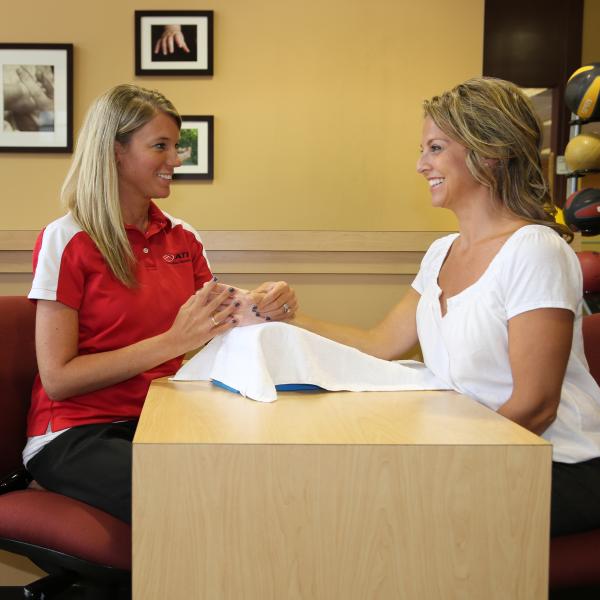
Authored by Eileen Scanlon, Hand Therapist with ATI Physical Therapy in West Dover, DE.
Being a new mother is a special time filled with wonder, joy . . . and for about 40 % of moms . . . wrist tendonitis. Caring for a newborn means frequent lifting and carrying the baby in positions that are awkward and unfamiliar to the body. This could lead to a painful inflammation of the tendons that pass through the wrist to the thumb known as “deQuervain’s tenosynovitis” named after a Swiss surgeon Fritz de Quervain. Newer more trendy names for this condition include “Mommy Thumb” and “Blackberry Thumb.”
This condition is particularly disconcerting for new mothers as the pain can be so severe that it prevents them from being able to care for their baby including even the simplest of task such as changing a diaper or snapping a bib.
Mommy Thumb Symptoms
The diagnosis is usually a clinical one and is made through a history and examination. The use of a provocative test called the Finkelstein Test is the assessment of choice and is considered to be reliable enough to support a clinical diagnosis. The test is positive if significant pain can be reproduced when the patient makes a fist (with the thumb on the inside of the fist) and bends the wrist down as if hammering.
Mommy Thumb Treatment
Intervention with hand therapy is focused on decreasing the inflammation of the tendons/sheath while working with the patient on eliminating or changing the aggravating activity. Not so easy when it comes to caring for a baby, but it is imperative to alter the way the wrist and thumb are used in order to allow for healing. Recovery is achieved through immobilization (custom orthotics), therapeutic modalities and activity modification. Non-responsive cases are considered for surgical release if they do not respond to cortisone injection(s) and a month or so of compliance with therapy.
How to Prevent Mommy Thumb
Prevention is difficult of course because mothers need to lift their babies. The key to avoiding further extension of deQuervain’s is early recognition and early treatment. Once a mother realizes she has the tendonitis, there are several things that can be implemented immediately that are very effective:
- Lift the baby differently. Try scooping up the baby by lifting him/her under the baby’s bottom versus picking them up with thumbs extended.
- Use of a baby carrier to transport the baby thereby freeing up the hands. Holding the baby while performing home activities places the wrist in awkward positions causing more strain.
- Alternate hands to share the load will help to distribute forces through the day.
- Use the elbows when possible to give the hands a rest. For example, hold the laundry basket close to the body with the elbows vs. lifting the handles.
- Use nursing supports to prevent awkward use of the wrist during feedings.
- Delegate aggravating activities to others if possible and ask others for help.
- If the activity hurts, stop doing it and find an alternate way. This is the simplest guideline but changing a habit is more than difficult for some.
Mommy Thumb Physical Therapy
If you are experiencing the symptoms of Mommy Thumb, stop by any ATI Hand Therapy location for a Complimentary Injury Screening. ATI Hand Therapy can evaluate your injury and provide you with options for continued care. You'll be seen by a licensed provider who will provide appropriate recommendations.
